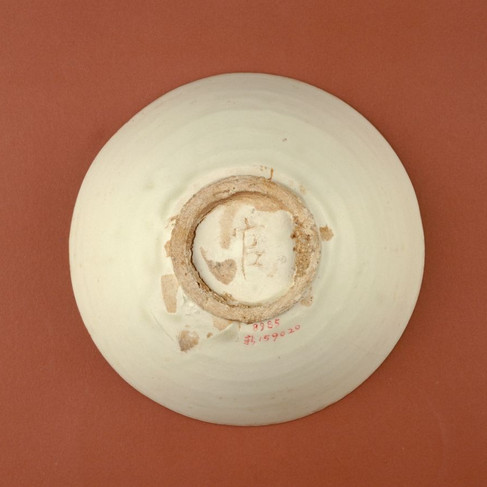宋代筆記 vol.138 北京故宮博物院:定窯白釉“官”字款碗 - Palace Museum Beijing, Ding Ware Bowl with ‘Official’ Mark, Five Dynasties
- SACA

- Jul 7
- 3 min read

定窯白釉“官”字款碗
新00195020
定窯白釉“官”字款碗,五代,高6.6釐米,口徑17釐米,足徑6釐米。
碗敞口,斜壁,圈足。胎體輕薄。碗裡外及圈足內均施白釉,釉色純正。足中心刻划“官”字。
此碗是五代時期河北曲陽定窯產品,屬同一時代白釉瓷器中的精品。

據考證,晚唐至北宋定窯瓷器銘款中以刻划“官”和“新官”者居多,僅1985年陝西西安北郊火燒壁出土晚唐定窯“官”字款白瓷就達33件之多。
1969年河北定縣靜志寺真身舍利塔基和淨眾院舍利塔基也曾出土17件北宋定窯刻划“官”和“新官”款的瓷器。在北京故宮博物院和台北故宮博物院,也有數件“官”字款定窯瓷器收藏,主要是盤、碗、水丞、罐等器物。
據不完全統計,目前所見國內外收藏的署“官”字款的定窯瓷器大約有80件左右。
過去曾有學者認為這些署“官”字款的瓷器中有一部分是遼代官窯的產品,但是,自從河北定縣兩座塔基出土大批“官”字款瓷器後,學術界基本統一了觀點,即認為“官”字款白瓷均為定窯產品。當年定窯部分作坊被皇室或官府徵用後,為防止與民用器物相混淆,特刻划”官”字,以示區別。與同時期不署款定窯瓷器相比較,這些“官”字款器製作工藝都相當精細,屬於精品,已達到宮廷用瓷的標準。

關於官、新官,參考SACA學會發表的文章:《展覽筆記 vol.2 唐五代定窯「官」款 西安火燒壁窖藏,西安博物館 - Ding Ware 'Official' and 'New Official' Marks, Tang to Five Dynasties Found at 'Huoshaobi', Xi'an Museum》
新官款:
官字款:
Ding Ware White-glazed Bowl with ‘Guan’ Mark
Accession Number: 新00195020
Date: Five Dynasties (907–960)
Dimensions: Height: 6.6 cm; Rim diameter: 17 cm; Foot diameter: 6 cm
Collection: The Palace Museum, Beijing
This bowl is a finely potted example of Ding ware from the Five Dynasties period, produced at the famed Ding kilns in Quyang, Hebei province. The vessel features a flared mouth, slanted walls, and a neatly cut ring foot. The body is thinly constructed and covered with a lustrous, pure white glaze that extends across both the interior and exterior, including the inner base of the foot. At the center of the foot, the Chinese character guan (官, “official”) is incised—a significant mark denoting government use.
Scholarly research has revealed that from the late Tang to the early Northern Song periods, Ding ware often bears incised inscriptions, with “官” (guan, official) and “新官” (xin guan, new official) being the most common. Notably, the 1985 excavation at Huoshaobi in the northern suburbs of Xi’an uncovered 33 white-glazed Ding vessels bearing the guan mark, dating to the late Tang. Similarly, in 1969, a total of 17 pieces bearing either guan or xin guan marks were unearthed from the reliquary bases of the Jingzhisi and Jingzhongyuan pagodas in Dingzhou, Hebei.
Today, examples of Ding ware with the guan mark are held in major collections, including the Palace Museums in both Beijing and Taipei. These vessels typically include bowls, dishes, ewers, brush washers, and jars. In total, approximately 80 examples of guan-marked Ding ware are known in public and private collections worldwide.
Earlier scholarship had speculated that some guan-marked pieces might have originated from Liao dynasty official kilns. However, following the discovery of a substantial number of such vessels at the aforementioned Northern Song pagoda sites in Dingzhou, a scholarly consensus has emerged: all guan-marked white wares are products of the Ding kilns. These wares are believed to have been produced in workshops requisitioned by the court or government, with the guaninscription serving as a distinguishing mark to separate them from privately made wares.
In terms of workmanship and glaze quality, these marked pieces are generally more refined than their unsigned counterparts, often achieving the high standards required for court use. They represent the institutionalization of official ceramic production in pre-Song China and stand as early prototypes for the imperial wares that would be formalized under later dynasties.























Comments